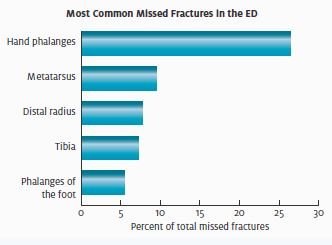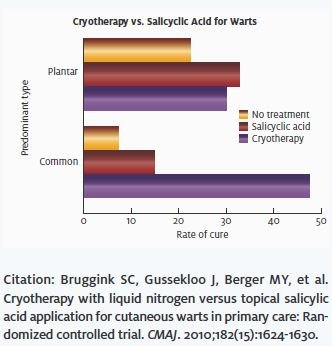Most Frequently Missed Fractures in the Pediatric Emergency Department
Key point: The most commonly missed fractures were pha- langes of the hand and metatarsal fractures.
Citation: Mounts J, Clinenpeel J, McGuire E, et al. Most frequently missed fractures in the emergency department. Clin Pediatr (Phila). 2010 Dec 2. [Epub ahead of print.]
This study quantified the types of extremity fractures most commonly missed on plain radiographs by pediatric emer- gency medicine specialists after an initial emergency depart- ment encounter.
From February 2006 to June 2009, extremity radiographs obtained in a pediatric ED in which a radiologist categorized the ED attendings’ read of “normal” as incorrect were tabulated. The authors also counted the total number of each type of radiograph completed when radiologists were unavailable. The percentage of each type of fracture missed was calculated based on the total number of missed fractures. It was found that a total of 220 fractures were missed during ED encounters in the study period. The most frequently missed fractures were of the hand phalanges (26.4%) fol- lowed by metatarsus (9.5%), distal radius (7.7%), tibia (7.3%), and phalanges of the foot (5.5%).
Emergency and urgent care physicians alike should be aware that the most commonly missed fractures in the ED were phalanges of the hand and metatarsal fractures.
Oral Ivermectin: A Good Option for Treatment of Head Lice
Key point: Ivermectin is effective for treating body lice and scabies, but few studies have evaluated the oral preparation for head lice in children.
Citation: Ameen M, Arenas R, Villanueva-Reyes J, et al. Oral ivermectin for treatment of pediculosis capitis. Pediatr Infect Dis J. 2010;29(11):991-993.
Pediculosis capitis (head lice) can lead to school absenteeism and, often, to parental anxiety. Treatment usually involves topical therapy that can be time consuming and painful if excoriations are present.

In addition, pediculicide resistance is increasing and can lead to treatment failure. Ivermectin is effective for treatment of body lice and scabies, but few studies have evaluated the oral preparation for head lice in children.
In an open-label study, investigators recruited 44 children (age range: 6 to 15 years) living in an indigenous community in Mexico with confirmed head lice and treated them with a single dose of oral ivermectin (200 µg/kg). No nit re- moval was included in the protocol.
One week after treatment, no children had adult live lice. Although 90% of children still had nits, most were nonviable. The 18 children with moderate-to-abundant nits received an additional dose of ivermectin; one week later, no viable nits were present. No adverse events were reported.
Ivermectin is not familiar to most pediatricians, but has been used successfully and safely for treatment of several helminthes.
Although this was a small, open-label trial, the results in- dicate that ivermectin is a safe and effective pediculicide in children older than 5 years.
Currently, resistance to ivermectin is not a concern, making the drug a good addition to the treatment options out- lined in the American Academy of Pediatrics revised clinical report on the management of head lice (JW Pediatr Adolesc Med, August 25, 2010).
Parents might prefer ivermectin because it is easy to use.
[Published in J Watch Pediatr Adolesc Med, December 15, 2010—Peggy Sue Weintrub, MD.] n
Echinacea for Treating the Common Cold: A Randomized Trial
Key point: Echinacea does not significantly reduce cold severity or duration.
Citation: Barrett B, Brown R, Rakel D, et al. Ann Intern Med. 2010;153:769-777.
Some 700 patients aged 12 to 80 with new-onset colds were randomized to receive open-label echinacea, blinded echinacea, placebo, or no pills for five days. Overall, self-reported cold duration was slightly improved by about half a day with echinacea compared with placebo or no pills, but this difference did not achieve statistical significance.
In addition, cold severity was slightly, but not significantly, improved with active treatment.
The researchers concluded that “the pharmacologic activity of echinacea probably has only a small beneficial effect in persons with the common cold….Individual choices about whether to use echinacea…should be guided by personal health values and preferences, as well as by the limited evidence available.”
Vapor Rub for Children with Nocturnal Cough and Cold Symptoms
Key point: In a single-night study, vapor rub improved cough and congestion symptoms in children.
Citation: Paul IM, Beiler JS, King TS, et al. Vapor rub, petrolatum, and no treatment for children with nocturnal cough and cold symptoms. Pediatrics. 2010;126(6):1092- 1099.
Many of us can recall the use of Vicks VapoRub during childhood. In a manufacturer-sponsored study, 138 children (age range, 2–11 years) seen at a single pediatric center in Pennsylvania for colds characterized by cough, rhinorrhea, and congestion for at least one week were randomized to re- ceive vapor rub, petrolatum, or no treatment for one night. In an attempt at blinding, parents in the vapor rub and petrolatum groups placed Vicks VapoRub under their own noses prior to applying treatment to their child’s upper chest and neck area before sleep.
Parents completed a six-item symptom survey at enrollment to assess symptoms on the night before treatment and the morning after.
Symptoms improved in all groups on the night after treatment. However, child and parent sleep and combined symptom scores improved significantly more in the vapor rub group than in the petrolatum and no-treatment groups.
In addition, vapor rub significantly reduced frequency of cough and severity of cough and congestion compared with no treatment; improvement approached statistical signifi- cance compared with petrolatum.
Almost half of the vapor rub group reported minor, ad- verse side effects, such as a burning sensation on the skin. Most parents knew the group that their child had been as- signed to (no treatment, 100%; vapor rub, 86%; petrolatum, 89%).
The obvious limitation of this study is the lack of successful blinding. However, because sleep is such an important commodity, recommending vapor rub for children seems reasonable.
[Published in J Watch Pediatr and Adolesc Med, November 24, 2010—Howard Bauchner, MD.]
Cryotherapy is More Effective than Salicylic Acid for Common Warts
Key point: No clinically significant difference between treatments for plantar warts was seen, but there are clear benefits for warts on hands.
Citation: Bruggink SC, Gussekloo J, Berger MY, et al. Cryotherapy with liquid nitrogen versus topical salicylic acid application for cutaneous warts in primary care: Randomized controlled trial. CMAJ. 2010;182(15):1624-1630.
Cutaneous warts are seen often in primary care, particularly among children, but a recent Cochrane review was inconclusive on the relative merits of the two most common treatments, salicylic acid and cryotherapy.
Dutch researchers randomized 250 patients (43% younger than 12 years) who were recruited from 30 primary care practices with one or more new cutaneous warts (<1 cm diameter) to receive cryotherapy with liquid nitrogen every two weeks, daily self-applications of 40% salicylic acid gel, or no treatment for 13 weeks.
Half the patients had predominantly common warts (mainly on the hands), and half had predominantly plan- tar warts. Among patients with predominantly common warts, warts were significantly more likely to resolve completely with cryotherapy than with salicylic acid or no treatment (49% vs. 15% and 8%, respectively).
Patients with predominantly plantar warts had similar cure rates regardless of treatment (30%, 33%, and 23%, respectively) and were more likely to be completely cured if they were younger than 12 years (50% vs. 3%) or if their warts had been present for <6 months (46% vs. 10%).
Cryotherapy caused more local side effects than salicylic acid did, but more patients who received cryotherapy were satisfied with their treatment.
This pragmatic primary care-based trial suggests that cryotherapy is the preferred treatment for common warts. Persistent plantar warts in adolescents and adults are unlikely to respond to brief therapy with either cryother- apy or salicylic acid.
[Published in J Watch Gen Med, November 30, 2010— Bruce Soloway, MD.]

